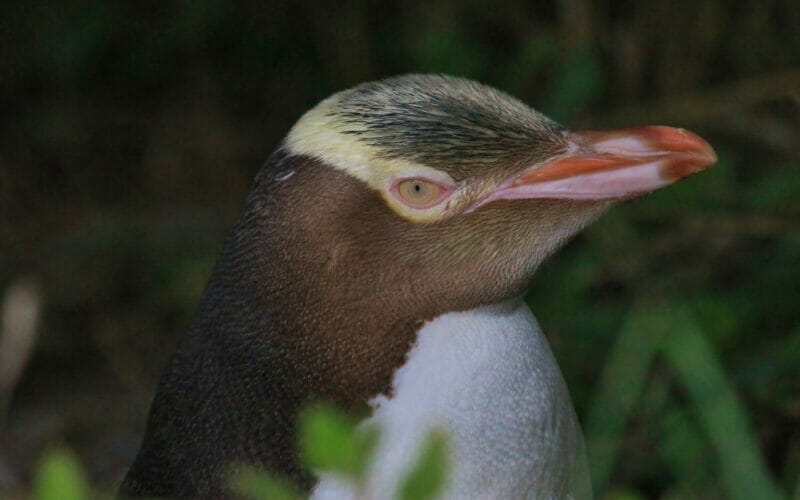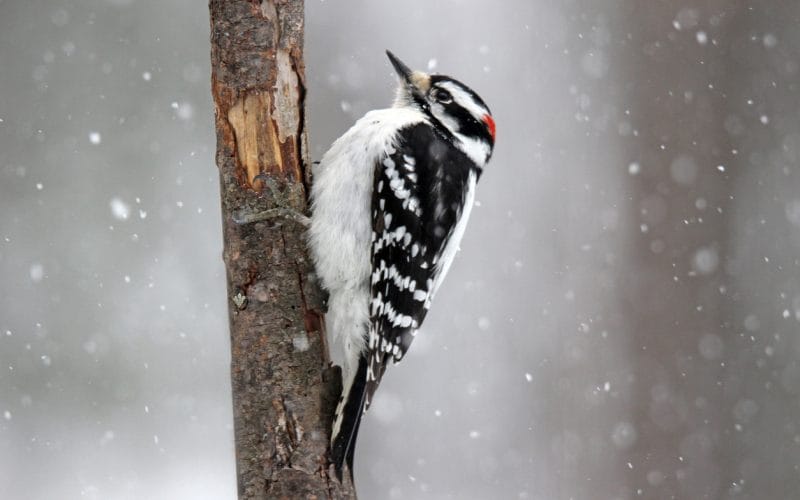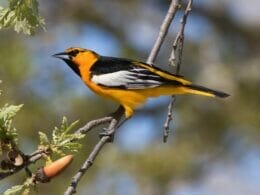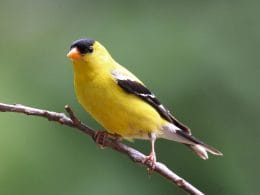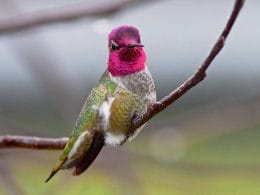Birds eat all sorts of food, from fruits and seeds to insects and reptiles. Today, we’re discussing 19 different species of birds that eat mosquitoes while sharing information to help you identify them.
Top 19 Birds That Eat Mosquitoes
1. Baltimore Oriole
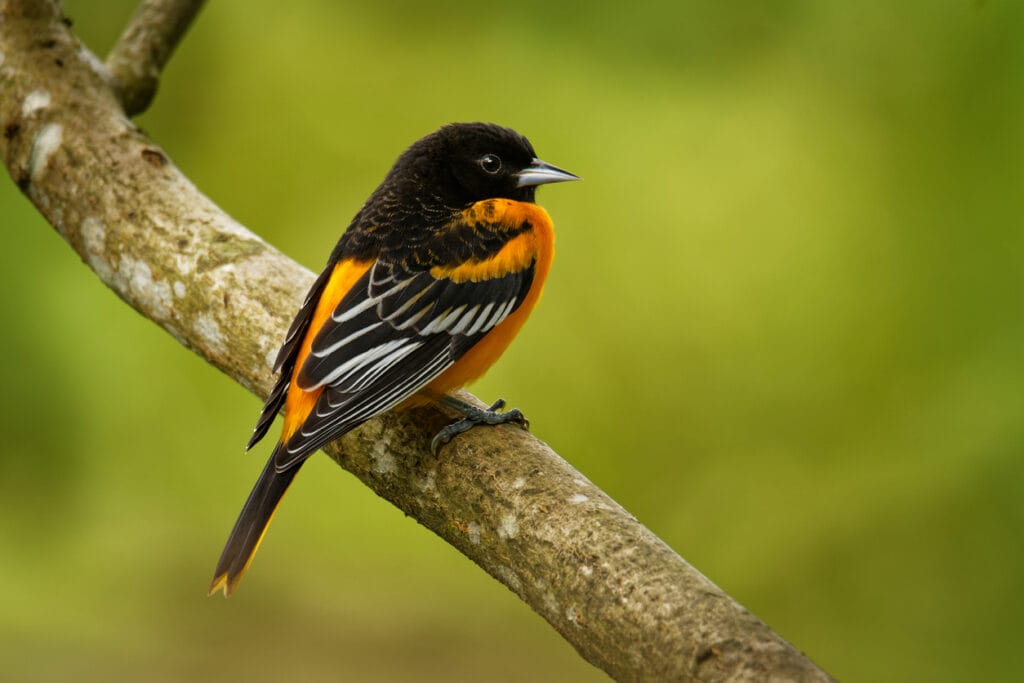
- Scientific name: Icterus galbula
- Length: 6.7 to 7.5 inches
- Wingspan: 9.1 to11.8 inches
- Weight: 1.1 to 1.4 ounces
The male Baltimore Oriole is known for having a bright orange underside with an all-black head and black wings with a single white stripe. Females are a paler orange-yellow on the breast, while their backs and heads are gray with two white stripes on the wings.
Author Note: Diet-wise, Baltimore Orioles munch on a wide array of insects including mosquitoes, flies, crickets, beetles, grasshoppers, ants, snails, moths, and spiders. They also eat many types of caterpillars, webworms, and larvae, as well as nectar and fruits such as mulberries, cherries, and raspberries.
2. Tree Swallow
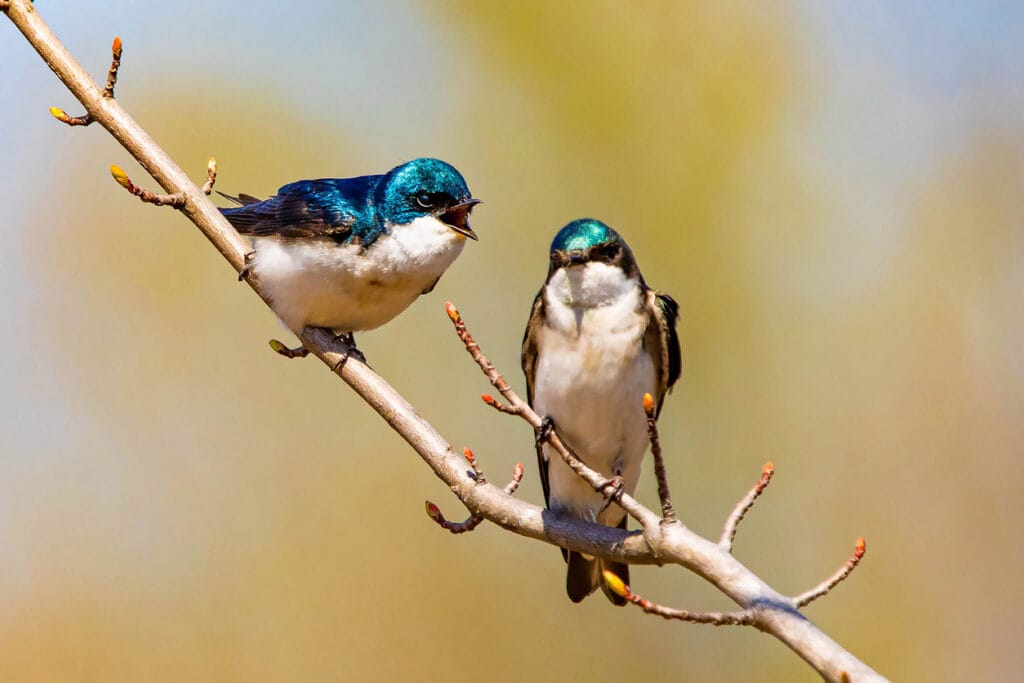
- Scientific name: Tachycineta bicolor
- Length: 4.7 to 5.9 inches
- Wingspan: 11.8 to 13.8 inches
- Weight: 0.6 to 0.9 ounces
Male Tree Swallows possess a stunning blue-green back and top of the head with white undersides, gray-black wings, and black eye masks. The females are more gray and brown above.
The diet of a Tree Swallow mainly consists of flying insects as they capture them in the air. These include mosquitoes, flies, dragonflies, ants, mayflies, damselflies, sawflies, bees, caddisflies, wasps, butterflies, true bugs, beetles, moths, and stoneflies.
They also eat roundworms, spiders, mollusks, clamshells, fish bones, and the exoskeletons of crayfish.
3. Northern Cardinal

- Scientific name: Cardinalis cardinalis
- Length: 8.3 to 9.1 inches
- Wingspan: 9.8 to 12.2 inches
- Weight: 1.5 to 1.7 ounces
This large songbird is characterized by having a protruding crest and a thick beak.
Male Northern Cardinals have bright red bodies and a red-orange beak with a black border around the bill. Females possess the same facial features but their plumage is a lot duller.
While they mainly munch on seeds and fruit, Northern Cardinals eat insects to supplement their diet and mostly feed insects to their nestlings. Examples of these insects include mosquitoes, crickets, beetles, flies, butterflies, katydids, moths, leafhoppers, spiders, and centipedes.
4. Purple Martin
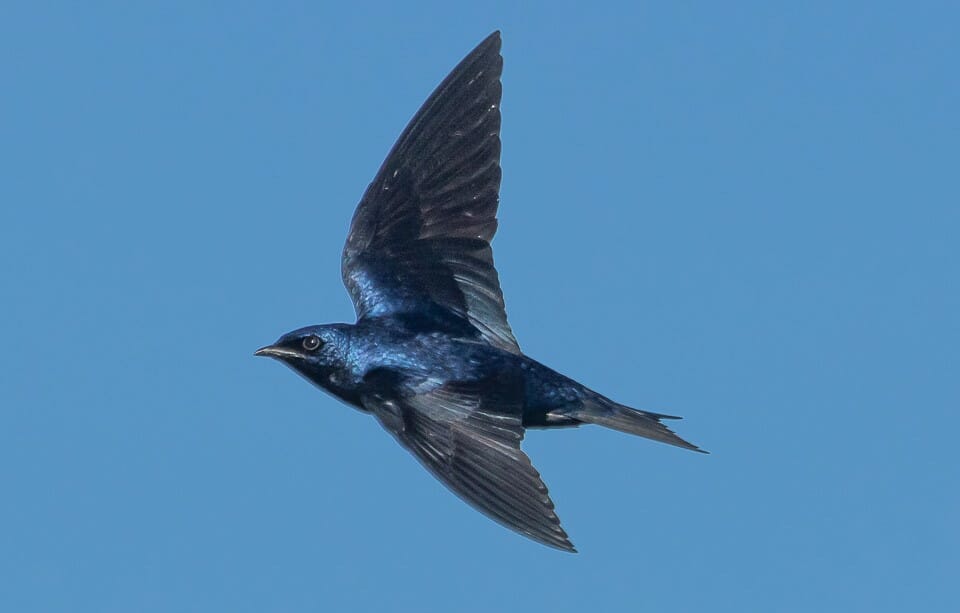
- Scientific name: Progne subis
- Length: 7.5 to 7.9 inches
- Wingspan: 15.3 to 16.1 inches
- Weight: 1.6 to 2.1 ounces
Purple Martins are pretty large for a swallow. Despite being called purple, the males show off a more blue plumage with a blackish tail and wings. Females are duller with gray shades on top and whitish lower undersides.
Purple Martins feed on insects year-round, both flying and non-flying varieties, using their tails to trap their prey.
Their diet includes flies, mosquitoes, bees, beetles, crickets, dragonflies, grasshoppers, mayflies, damselflies, butterflies, leafhoppers, wasps, moths, caddisflies, cicadas, spiders, and termites.
5. Eastern Kingbird
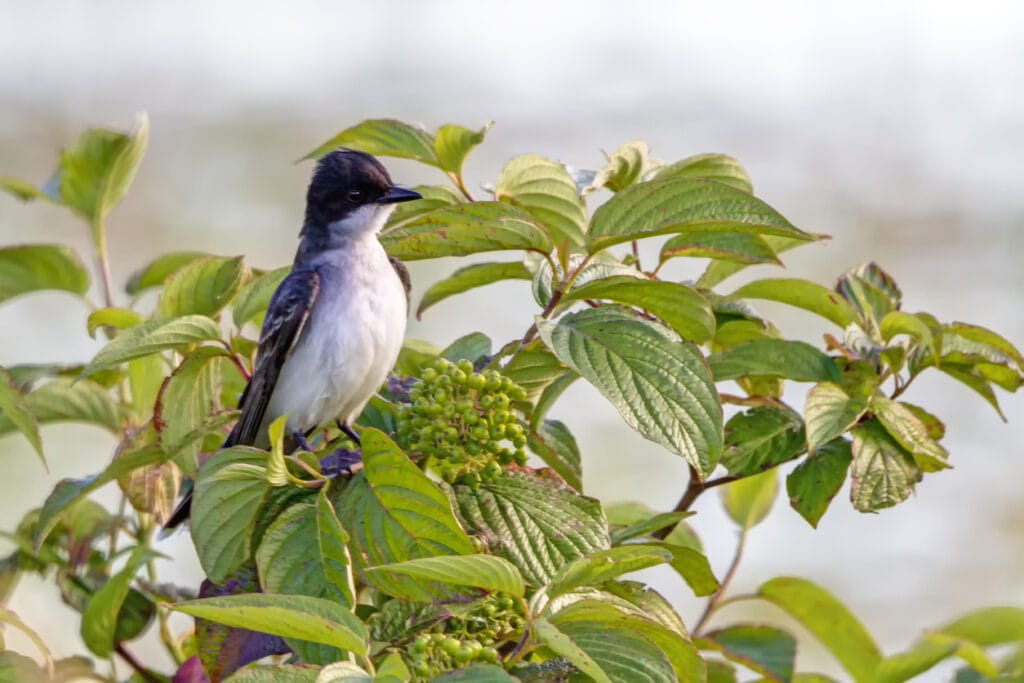
- Scientific name: Tyrannus tyrannus
- Length: 7.5 to 9.1 inches
- Wingspan: 13.0 to 15.0 inches
- Weight: 1.2 to 1.9 ounces
Eastern Kingbirds are medium-sized songbirds with black backs and white undersides. Their tails are also black with a white tip while the top of their heads is a more intense black.
Author Note: When it comes to food, Eastern Kingbirds are mainly insectivores. They munch on a wide array of flying varieties such as mosquitoes, bees, wasps, ants, crickets, beetles, grasshoppers, flies, and locusts.
Other than mid-air, sometimes these birds turn to plants, water surfaces, and the ground to find insects.
6. Barn Swallow
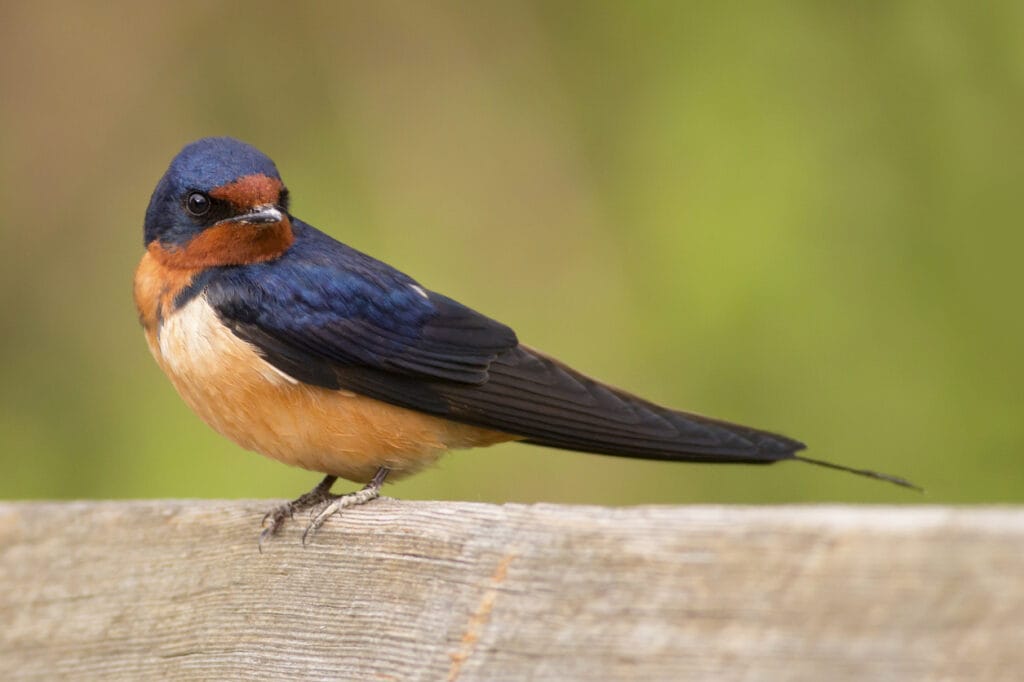
- Scientific name: Hirundo rustica
- Length: 5.9 to 7.5 inches
- Wingspan: 11.4 to 12.6 inches
- Weight: 5.9 to 7.5 ounces
A bit bigger than Tree Swallows, Barn Swallows are steely blue above and rufous below. Their faces are cinnamon-colored and their crowns are a rich blue.
Their insect-based diet consists mainly of pretty much every type of fly out there. They also eat other flying bugs such as mosquitoes, bees, beetles, ants, wasps, moths, and butterflies.
7. Black-capped Chickadee

- Scientific name: Poecile atricapillus
- Length: 4.7 to 5.9 inches
- Wingspan: 6.3 to 8.3 inches
- Weight: 0.3 to 0.5 ounces
With an oversized head and a rounded body, this adorable Chickadee has a black cap and beak with a gray back. Its cheeks are white and its underside is a buff-white color.
The diet of a Black-capped Chickadees contains insects, ranging from mosquitoes to spiders, no matter the season. In winter, they make up about 50% of their food, while in spring and summer, insects become about 90% of the menu.
8. Blackpoll Warbler
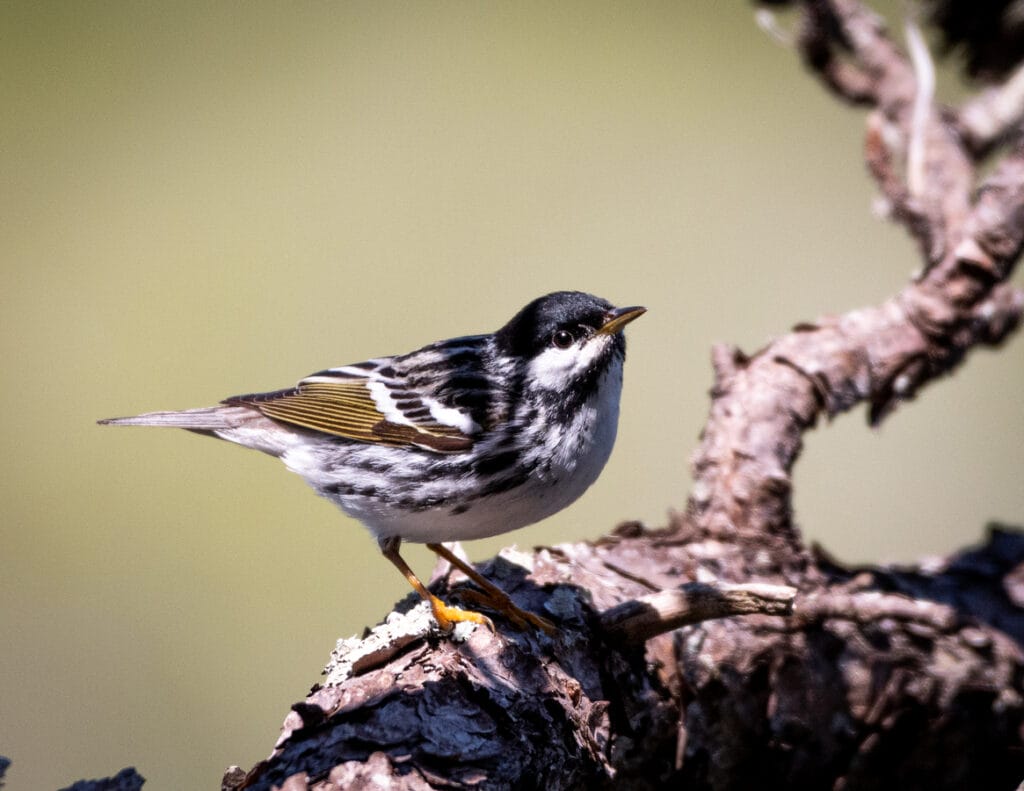
- Scientific name: Setophaga striata
- Length: 5.5 inches
- Wingspan: 8.3 to 9.1 inches
- Weight: 0.4 to 0.5 ounces
Blackpoll Warblers are small songbirds with a very interesting color pattern.
During the breeding season, they show off a black-and-white plumage with a unique black cap and a black mustache mark bordering white cheeks. In the non-breeding season, they become a pale green-yellow.
Author Note: The diet of Blackpoll Warblers mainly consists of insects such as mosquitoes, gnats, flies, caterpillars, beetles, ants, and lice. They also eat spiders and fruits such as pokeberry and honeysuckle.
9. Great Titmouse
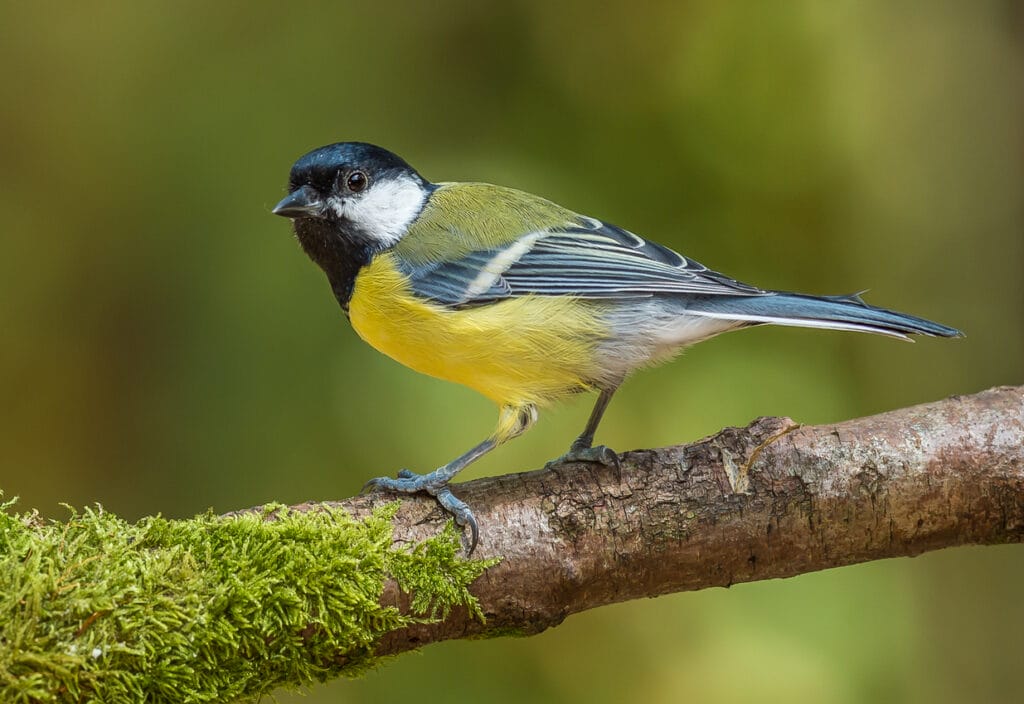
- Scientific name: Parus major
- Length: 4.9 to 5.5 inches
- Wingspan: 8.9 to 10.0 inches
- Weight: 0.5 to 0.8 ounces
The Great Titmouse is a common garden bird that looks rather cool. It has a pale gray-blue tail with a single white stripe at the tip. It’s green-gray above with a black head and contrasting big white cheeks.
What’s particularly unique is that the black color runs from the head to the throat down to the middle of the belly. Both sides of the breast are lemon yellow.
Great Titmice love to feed on nuts, seeds, and insects such as mosquitoes and flies.
10. Chipping Sparrow

- Scientific name: Spizella passerina
- Length: 4.7 to 5.9 inches
- Wingspan: 8.3 inches
- Weight: 0.4 to 0.6 ounces
If a sparrow ever looks crisp and neat, it’s the Chipping Sparrows. It has a pale face and underparts with a bright copper crown and a black stripe that runs across the eye.
The diet of a Chipping Sparrow is mainly a variety of seeds, but it also eats insects -especially during the breeding season- to ensure they get a lot of protein.
11. Nashville Warbler
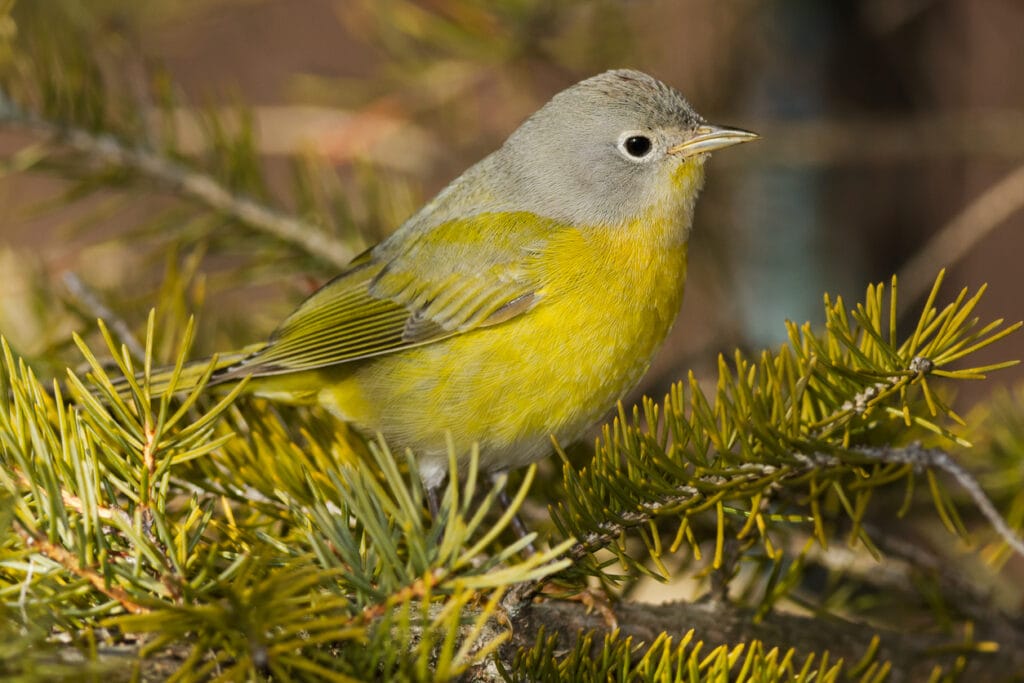
- Scientific name: Leiothlypis ruficapilla
- Length: 4.3 to 5.1 inches
- Wingspan: 6.7 to 7.9 inches
- Weight: 0.2 to 0.5 ounces
The Nashville Warbler is a compact bird with mostly yellow, green, and gray plumage. It has pitch-black eyes with a thin white ring surrounding each one. Its underside has a white patch between a bright yellow breast and undertail.
The year-round diet of a Nashville Warbler almost exclusively consists of insects. The menu includes mosquitoes, flies, beetles, grasshoppers, spruce budworms, leafhoppers, and caterpillars.
12. Eastern Phoebe
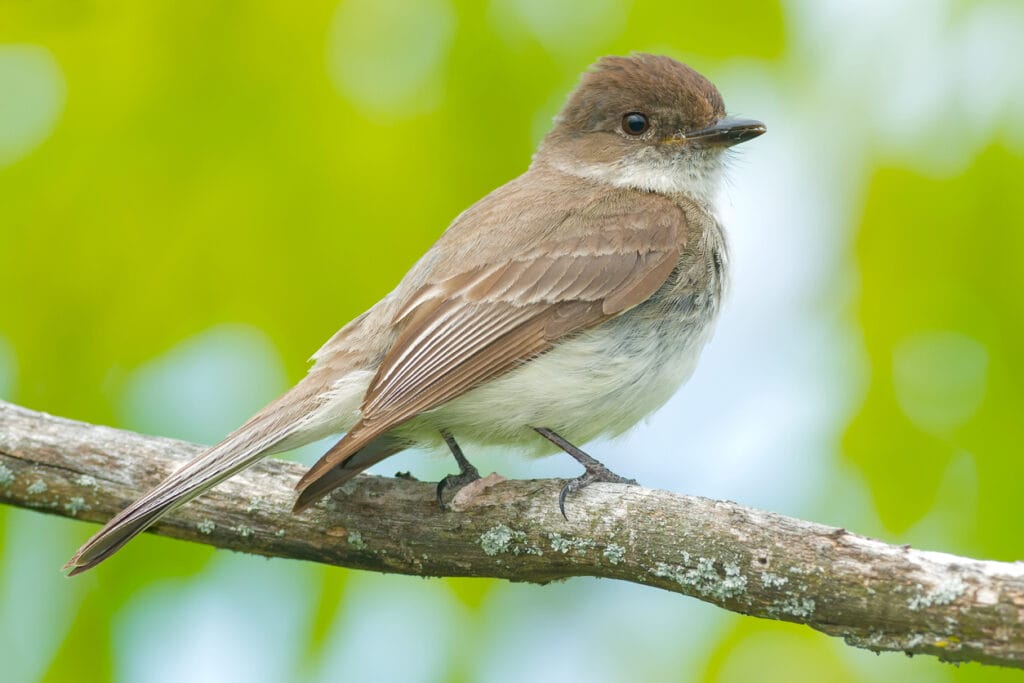
- Scientific name: Sayornis phoebe
- Length: 5.5 to 6.7 inches
- Wingspan: 10.2 to 11.0 inches
- Weight: 0.6 to 0.7 ounces
Medium-sized and plump, the Eastern Phoebe possesses a brown-gray plumage that’s dark above and pale below. Its head is a darker brown than the rest of its body.
When it comes to the diet of the Eastern Phoebe, flying insects are most of the items on the menu. They like to feed on mosquitoes, moths, wasps, flies, beetles, midges, and dragonflies.
Top Tip: These birds also munch on butterflies, cicadas, spiders, millipedes, and ticks. Occasionally, they’ll eat seeds or small fruits.
13. American Robin
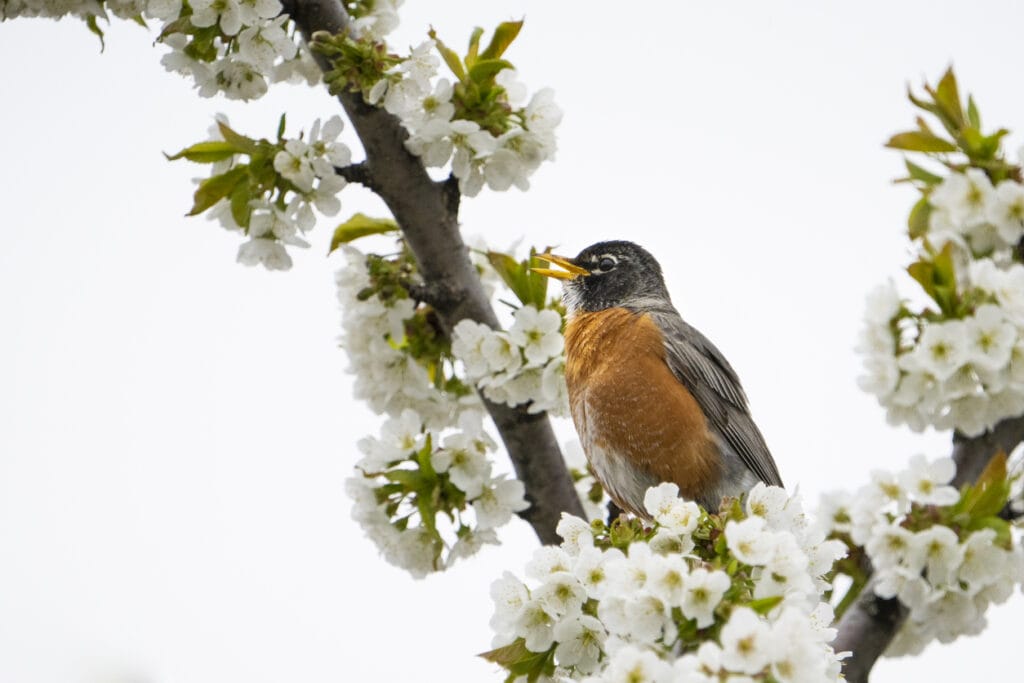
- Scientific name: Turdus migratorius
- Length: 7.9 to 11.0 inches
- Wingspan: 12.2 to 15.8 inches
- Weight: 2.7 to 3.0 ounces
The plumage of American Robins is gray-brown above and copper-orange below. The heads are darker in males but both sexes have a white patch under the tail that appears in flight.
Diet-wise, American Robins mainly feed on insects, invertebrates, and fruit. They eat a lot of flies, moths, mosquitoes, earthworms, and snails.
They’re also big on juniper berries, chokecherries, sumac, hawthorn, and dogwood.
Bluebirds
The Western Bluebird, Eastern Bluebird, and Mountain Bluebird all include insects as part of their diet. Let’s take a closer look at the latter:
14. Mountain Bluebird
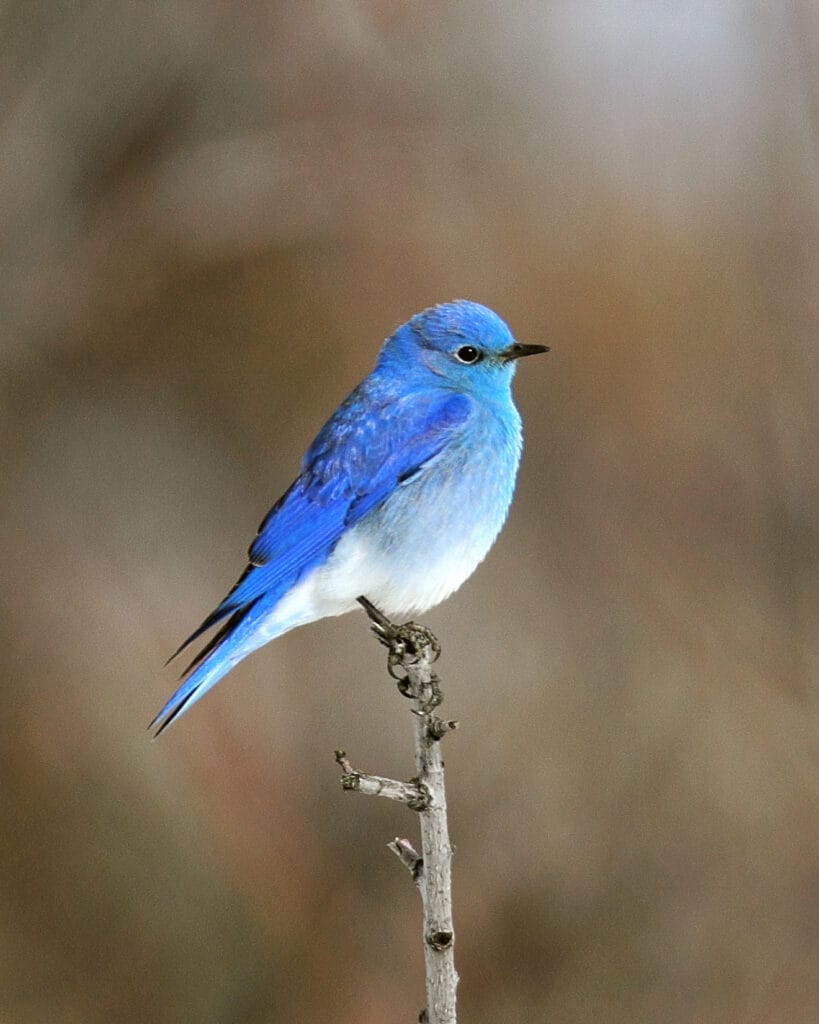
- Scientific name: Sialia currucoides
- Length: 6.3 to 7.9 inches
- Wingspan: 11.0 to 14.2 inches
- Weight: 1.1 ounces
The male of the species is sky-blue above and white below with a darker shade of blue on the tail and wings. On the other hand, females are brown-gray with pale blue highlights on the tail and wings.
The diet of Mountain Bluebirds is mostly insects such as flies, mosquitoes, beetles, caterpillars, spiders, and grasshoppers. In the winter, they can resort to seeds and small fruits -such as grapes and sumac- when insects aren’t as readily available.
Woodpeckers
Just about every species of woodpeckers eats mosquitoes because their diets heavily consist of insects. Here are two common woodpeckers that eat mosquitoes:
15. Downy Woodpecker

- Scientific name: Dryobates pubescens
- Length: 5.5 to 6.7 inches
- Wingspan: 0.7 to 1.0 inches
- Weight: 9.8 to 11.8 ounces
Downy Woodpeckers look like the classic woodpecker form but smaller. Their plumage has bold black and white stripes, while the wings are more checkered. Males of the species have a red mark on the back of the head.
Downy Woodpeckers have an insect-based diet where they feed on beetles, beetle larvae, corn earworms, mosquitoes, tent caterpillars, apple borers, and bark beetles. They also eat grains, berries, acorns, and suet from feeders.
16. Black-backed Woodpecker

- Scientific name: Picoides arcticus
- Length: 9.1 inches
- Wingspan: 15.8 to 16.5 inches
- Weight: 2.1 to 3.1 ounces
The Black-backed Woodpecker has an inky black back and a white underside with black barring on the sides. Males possess a yellow patch on the crown, which is absent in adult females.
Author Note: The diet of Black-backed Woodpeckers is pretty much all insects. They love to munch mosquitoes, beetles, and beetle larvae.
These birds find their food on the trunks and limbs of trees, especially burned ones. The species is even considered the most specialized forager woodpecker in North America.
Wrens
Wrens are songbirds that love eating mosquitoes. Let’s take a look at one of the most common wrens in the country:
17. Carolina Wren
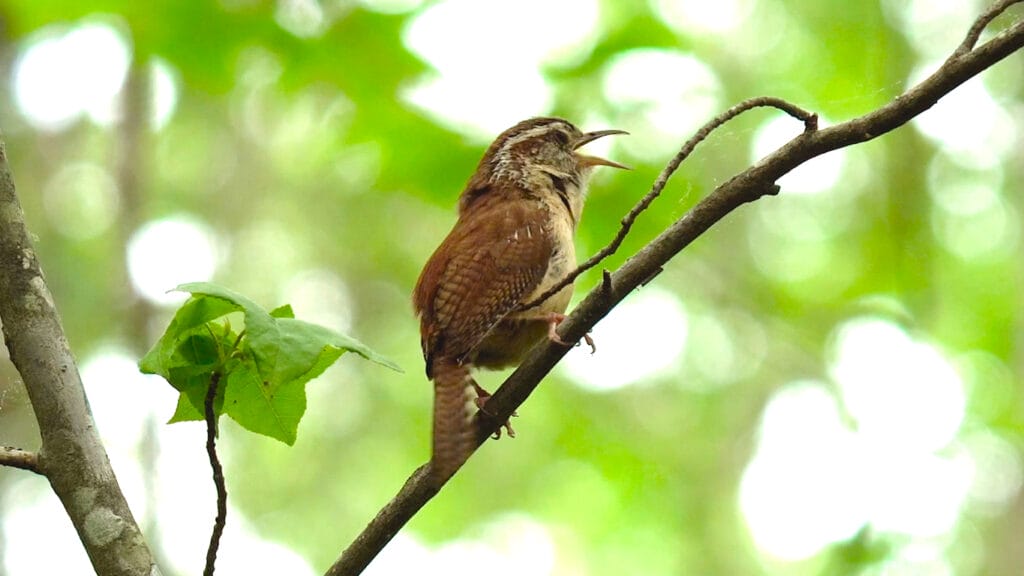
- Scientific name: Thryothorus ludovicianus
- Length: 4.7 to 5.5 inches
- Wingspan: 11.4 inches
- Weight: 0.6 to 0.8 ounces
Whether it’s a male or a female, a Corlina Wren is rich brown above and pale brown below. It has a dark brown beak, an extended white eyebrow stripe, and a white throat.
Carolina Wrens primarily feed on Insects and spiders. Their prey includes moths, mosquitoes, caterpillars, stick bugs, crickets, leafhoppers, cockroaches, beetles, and grasshoppers.
Sometimes, these birds will also eat frogs, snakes, or lizards.
Nuthatches
Nuthatches chase their prey in the air, so it’s no surprise they love to eat flying insects. Here are two species that eat mosquitoes:
18. Brown-headed Nuthatch

- Scientific name: Sitta pusilla
- Length: 3.9 to 4.3 inches
- Wingspan: 6.3 to 7.1 inches
- Weight: 0.3 ounces
True to its name, the Brown-headed Nuthatch has a brown head, gray back, and white underside. On the back of its head, there’s a white patch.
Top Tip: The diet of Brown-headed Nuthatches heavily depends on insects including cockroaches, mosquitoes, flies, and beetles. They look for their prey under barks on tree branches, trunks, twigs, and clusters of pine needles.
19. Red-breasted Nuthatch
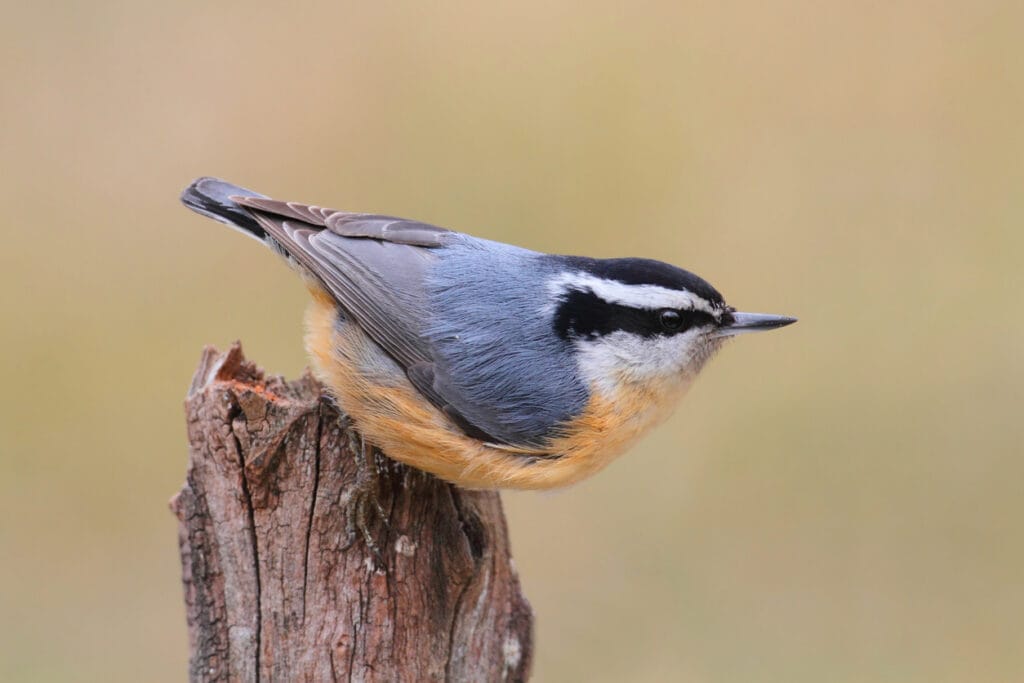
- Scientific name: Sitta canadensis
- Length: 4.3 inches
- Wingspan: 7.1 to 7.9 inches
- Weight: 0.3 to 0.5 ounces
Last but not least, the Red-breasted Nuthatch is gray-blue above and rusty brown below. It has a black cap, followed by a white strip then a black stripe through the eyes.
Red-breasted Nuthatches munch mainly on insects including ants, beetles, earwigs, caterpillars, mosquitoes, and spiders. They also eat conifer seeds, peanuts, suet, and sunflower seeds.
Wrap Up
There you have it, 19 different species of birds that eat mosquitoes. If you’re looking to attract some of these birds to help control mosquitoes at your home, be sure to provide bird feeders, birdbaths, and fruit-bearing plants in your garden.
FAQ
Some birds that are known to eat mosquitoes include purple martins and swallows.
Mosquitoes are attracted to birds to some extent as they feed on their blood.
Birds like purple martins and swallows help keep mosquitoes away by consuming them as a food source.
To attract birds that eat mosquitoes, you can provide a suitable habitat for them by putting up birdhouses or installing birdbaths. You can also attract these birds by providing them with a reliable food source, such as nectar, seeds, or insects. Planting native plants that produce nectar or fruit can also attract these birds to your yard.





